Abstract
The purpose of these experiments was to determine the degree of reduction in the number of antigen-binding B lymphocytes in the spleens of mice that had been rendered tolerant in the perinatal period. Newborn or pregnant mice were injected with fluorescein (Flu) coupled onto human gamma globulin, and the spleen cells of the neonatally injected mice, or of the offspring of the pregnant mice, were analyzed 1-6 weeks later. Tolerogen doses were chosen so as to achieve either a two-thirds reduction (low dose) in the number of anti-Flu B cells capable of yielding anti-hapten plaque-forming cell clones after in vitro stimulation, or as representing a supra-optimal tolerogenic stimulus (high dose). Antigen-binding B cells were studied by a two-cycle procedure, namely an initial cycle of binding to Flu-gelatin thin layers, followed by analysis of the binding cells in the fluorescence-activated cell sorter (FACS) after suitable staining with Flu-protein conjugates. With the high dose of tolerogen, a modest diminution in Flu-binding cell numbers down to 56-71% of control values could be induced. When these residual Flu-specific B cells were analyzed in the FACS to quantitate their spectrum of Flu-binding avidities, profiles identical to those of controls were obtained. The reduction proved transient in nature, binding cell numbers having returned to 80% of normal by 2 weeks and to normal by 6 weeks. Nevertheless, the Flu-specific B cells were incapable of responding to antigen or mitogen by antibody formation. With the low dose of tolerogen, despite the desired degree of functional silencing of Flu-specific B cells, the numbers and avidity spectra of antigen-binding cells were entirely normal in both the neonatally injected and in utero-injected groups. The results indicate that tolerance induced amongst immature B lymphocytes is not due to a physical elimination of the relevant B cell clones or to a modulation or blockade of their surface Ig receptors. Rather, it is due to the recognition and storage of negative signals amongst cells that continue to display a normal complement of receptors. We therefore propose that the term “clonal anergy” is a more accurate description than either “clonal deletion” or “clonal abortion.”
Keywords: fluorescence-activated cell sorter, antibody formation, fluorescein-conjugated human gamma globulin
Full text
PDF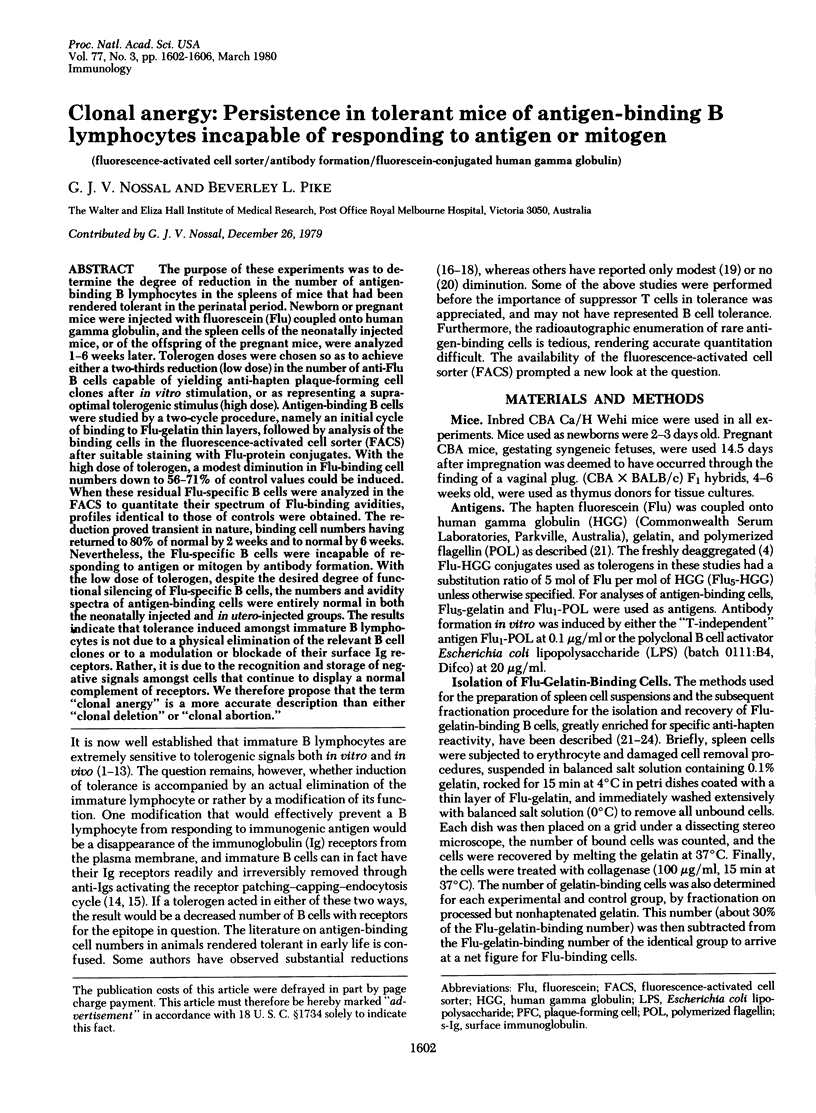
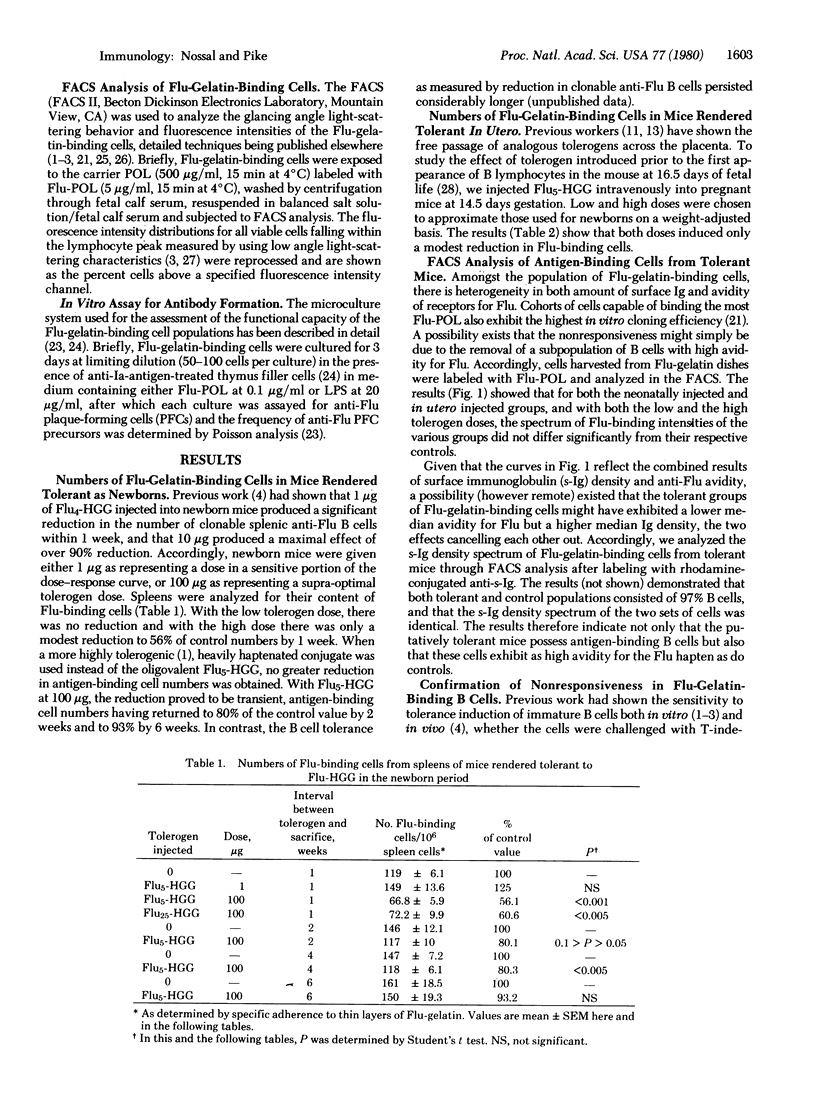
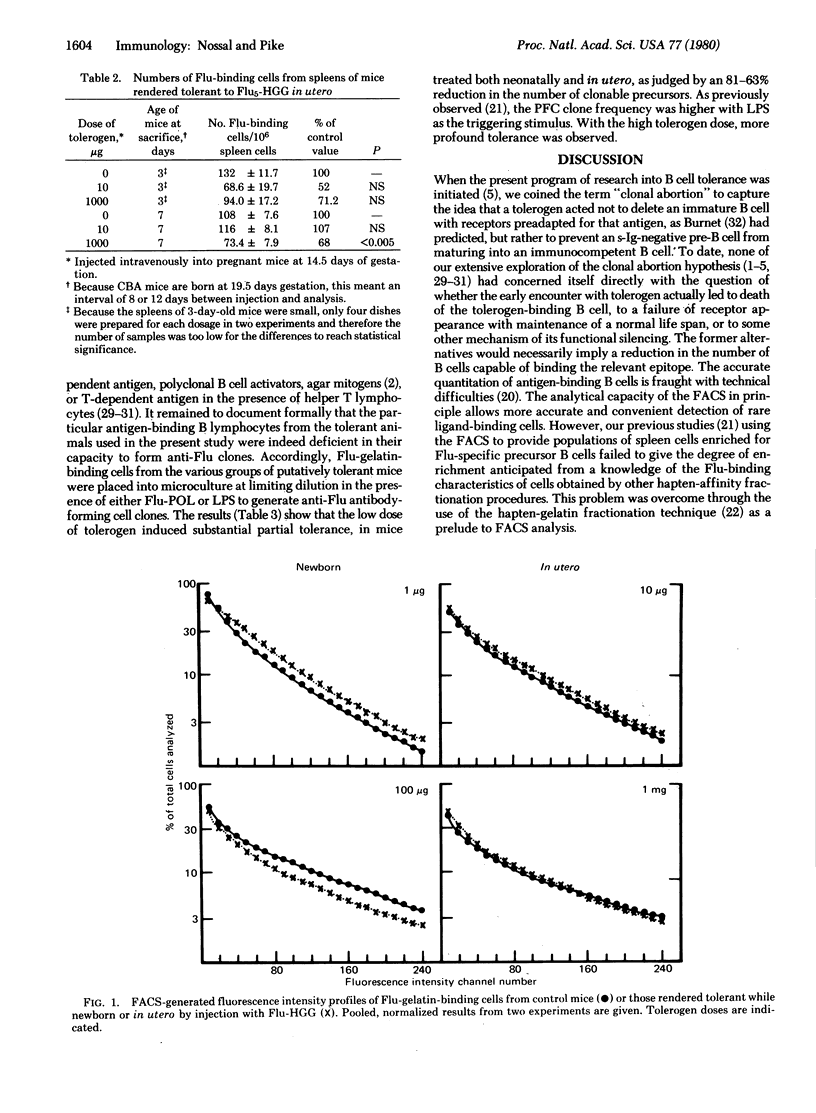
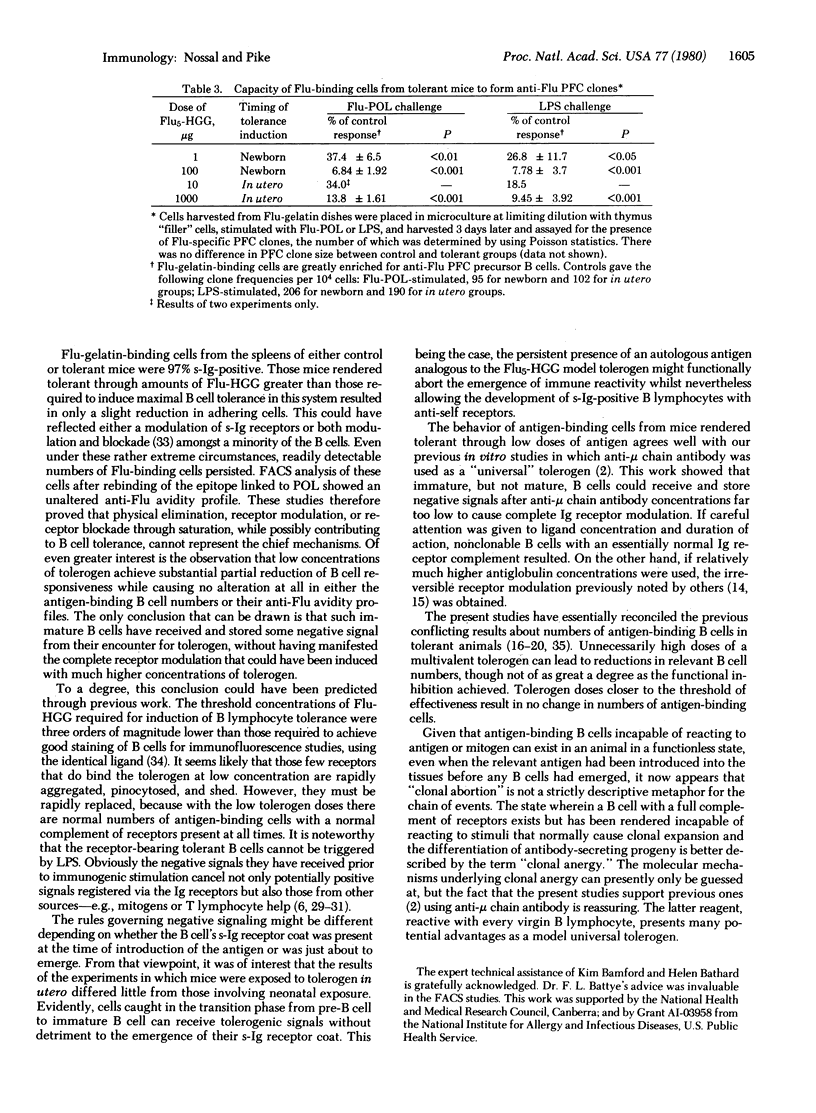
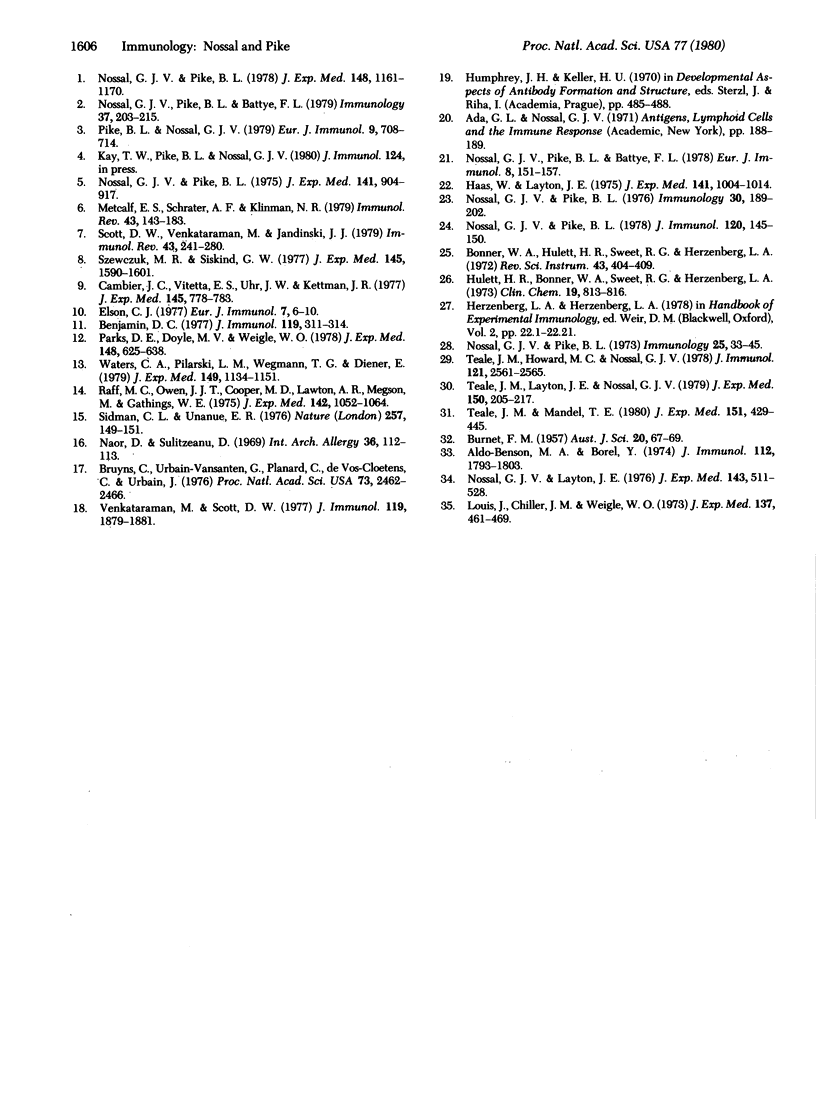
Selected References
These references are in PubMed. This may not be the complete list of references from this article.
- Aldo-Benson M., Borel Y. The tolerant cell: direct evidence for receptor blockade by tolerogen. J Immunol. 1974 May;112(5):1793–1803. [PubMed] [Google Scholar]
- Benjamin D. C. Neonatally induced tolerance to HGG: duration in B cells and absence of specific suppressor cells. J Immunol. 1977 Jul;119(1):311–314. [PubMed] [Google Scholar]
- Bonner W. A., Hulett H. R., Sweet R. G., Herzenberg L. A. Fluorescence activated cell sorting. Rev Sci Instrum. 1972 Mar;43(3):404–409. doi: 10.1063/1.1685647. [DOI] [PubMed] [Google Scholar]
- Bruyns C., Urbain-Vansanten G., Planard C., Vos-Cloetens C., Urbain J. Ontogeny of mouse B lymphocytes and inactivation by antigen of early B lymphocytes. Proc Natl Acad Sci U S A. 1976 Jul;73(7):2462–2466. doi: 10.1073/pnas.73.7.2462. [DOI] [PMC free article] [PubMed] [Google Scholar]
- Cambier J. C., Vitetta E. S., Uhr J. W., Kettman J. R. B-cell tolerance. II. Trinitrophenyl human gamma globulin-induced tolerance in adult and neonatal murine B cells responsive to thymus-dependent and independent forms of the same hapten. J Exp Med. 1977 Mar 1;145(3):778–783. doi: 10.1084/jem.145.3.778. [DOI] [PMC free article] [PubMed] [Google Scholar]
- Elson C. J. Tolerance in differentiating B lymphocytes. Eur J Immunol. 1977 Jan;7(1):6–10. doi: 10.1002/eji.1830070103. [DOI] [PubMed] [Google Scholar]
- Haas W., Layton J. E. Separation of antigen-specific lymphocytes. I. Enrichment of antigen-binding cells. J Exp Med. 1975 May 1;141(5):1004–1014. doi: 10.1084/jem.141.5.1004. [DOI] [PMC free article] [PubMed] [Google Scholar]
- Hulett H. R., Bonner W. A., Sweet R. G., Herzenberg L. A. Development and application of a rapid cell sorter. Clin Chem. 1973 Aug;19(8):813–816. [PubMed] [Google Scholar]
- LIND P. E., BURNET F. M. Recombination between virulent and non-virulent strains of influenza virus. II. The behaviour of virulence markers on recombination. Aust J Exp Biol Med Sci. 1957 Feb;35(1):67–78. doi: 10.1038/icb.1957.8. [DOI] [PubMed] [Google Scholar]
- Louis J., Chiller J. M., Weigle W. O. Fate of antigen-binding cells in unresponsive and immune mice. J Exp Med. 1973 Feb 1;137(2):461–469. doi: 10.1084/jem.137.2.461. [DOI] [PMC free article] [PubMed] [Google Scholar]
- Metcalf E. S., Schrater A. F., Klinman N. R. Murine models of tolerance induction in developing and mature B cells. Immunol Rev. 1979;43:142–183. doi: 10.1111/j.1600-065x.1979.tb00421.x. [DOI] [PubMed] [Google Scholar]
- Naor D., Sulitzeanu D. Binding of 125I-BSA to lymphoid cells of tolerant mice. Int Arch Allergy Appl Immunol. 1969;36(1):112–113. doi: 10.1159/000230728. [DOI] [PubMed] [Google Scholar]
- Nossal G. J., Layton J. E. Antigen-induced aggregation and modulation of receptors on hapten-specific B lymphocytes. J Exp Med. 1976 Mar 1;143(3):511–528. doi: 10.1084/jem.143.3.511. [DOI] [PMC free article] [PubMed] [Google Scholar]
- Nossal G. J., Pike B. L., Battye F. L. Mechanisms of clonal abortion tolerogenesis. II. Clonal behaviour of immature B cells following exposure to anti-mu chain antibody. Immunology. 1979 May;37(1):203–215. [PMC free article] [PubMed] [Google Scholar]
- Nossal G. J., Pike B. L., Battye F. L. Sequential use of hapten-gelatin fractionation and fluorescence-activated cell sorting in the enrichment of hapten-specific B llymphocytes. Eur J Immunol. 1978 Mar;8(3):151–157. doi: 10.1002/eji.1830080302. [DOI] [PubMed] [Google Scholar]
- Nossal G. J., Pike B. L. Evidence for the clonal abortion theory of B-lymphocyte tolerance. J Exp Med. 1975 Apr 1;141(4):904–917. [PMC free article] [PubMed] [Google Scholar]
- Nossal G. J., Pike B. L. Improved procedure for the fraction and in vitro stimulation of hapten-specific B lymphocytes. J Immunol. 1978 Jan;120(1):145–150. [PubMed] [Google Scholar]
- Nossal G. J., Pike B. L. Mechanisms of clonal abortion tolerogenesis. I. Response of immature hapten-specific B lymphocytes. J Exp Med. 1978 Nov 1;148(5):1161–1170. doi: 10.1084/jem.148.5.1161. [DOI] [PMC free article] [PubMed] [Google Scholar]
- Nossal G. J., Pike B. L. Single cell studies on the antibody-forming potential of fractionated, hapten-specific B lymphocytes. Immunology. 1976 Feb;30(2):189–202. [PMC free article] [PubMed] [Google Scholar]
- Nossal G. J., Pike B. L. Studies on the differentiation of B lymphocytes in the mouse. Immunology. 1973 Jul;25(1):33–45. [PMC free article] [PubMed] [Google Scholar]
- Parks D. E., Doyle M. V., Weigle W. O. Induction and mode of action of suppressor cells generated against human gamma globulin. I. An immunologic unresponsive state devoid of demonstrable suppressor cells. J Exp Med. 1978 Sep 1;148(3):625–638. doi: 10.1084/jem.148.3.625. [DOI] [PMC free article] [PubMed] [Google Scholar]
- Pike B. L., Nossal G. J. Mechanisms of clonal abortion tolerogenesis. III. Antigen abrogates functional maturation of surface immunoglobulin-negative adult bone marrow lymphocytes. Eur J Immunol. 1979 Sep;9(9):708–714. doi: 10.1002/eji.1830090909. [DOI] [PubMed] [Google Scholar]
- Raff M. C., Owen J. J., Cooper M. D., Lawton A. R., 3rd, Megson M., Gathings W. E. Differences in susceptibility of mature and immature mouse B lymphocytes to anti-immunoglobulin-induced immunoglobulin suppression in vitro. Possible implications for B-cell tolerance to self. J Exp Med. 1975 Nov 1;142(5):1052–1064. doi: 10.1084/jem.142.5.1052. [DOI] [PMC free article] [PubMed] [Google Scholar]
- Scott D. W., Venkataraman M., Jandinski J. J. Multiple pathways of B lymphocyte tolerance. Immunol Rev. 1979;43:241–280. doi: 10.1111/j.1600-065x.1979.tb00424.x. [DOI] [PubMed] [Google Scholar]
- Sidman C. L., Unanue E. R. Receptor-mediated inactivation of early B lymphocytes. Nature. 1975 Sep 11;257(5522):149–151. doi: 10.1038/257149a0. [DOI] [PubMed] [Google Scholar]
- Szewczuk M. R., Siskind G. W. Ontogeny of B-lymphocyte function. III. In vivo and in vitro studies on the ease of tolerance induction in B lymphocytes from fetal, neonatal, and adult mice. J Exp Med. 1977 Jun 1;145(6):1590–1601. doi: 10.1084/jem.145.6.1590. [DOI] [PMC free article] [PubMed] [Google Scholar]
- Teale J. M., Howard M. C., Nossal G. J. B lymphocyte subpopulations separated by velocity sedimentation. II. Characterization of tolerance susceptibility. J Immunol. 1978 Dec;121(6):2561–2565. [PubMed] [Google Scholar]
- Teale J. M., Layton J. E., Nossal G. J. In vitro model for natural tolerance to self-antigens. Inhibition of the development of surface-immunoglobulin-negative lymphocytes into T-dependent responsive B cells by antigen. J Exp Med. 1979 Aug 1;150(2):205–217. doi: 10.1084/jem.150.2.205. [DOI] [PMC free article] [PubMed] [Google Scholar]
- Teale J. M., Mandel T. E. Ontogenic development of B-lymphocyte function and tolerance susceptibility in vivo and in an in vitro organ culture system. J Exp Med. 1980 Feb 1;151(2):429–445. doi: 10.1084/jem.151.2.429. [DOI] [PMC free article] [PubMed] [Google Scholar]
- Venkataraman M., Scott D. W. Cellular events in tolerance. VI. Neonatal vs adult B cell tolerance: differences in antigen-binding cell patterns and lipopolysaccharide stimulation. J Immunol. 1977 Dec;119(6):1879–1881. [PubMed] [Google Scholar]
- Waters C. A., Pilarski L. M., Wegmann T. G., Diener E. Tolerance induction during ontogeny. I. Presence of active suppression in mice rendered tolerant to human gamma-globulin in utero correlates with the breakdown of the tolerant state. J Exp Med. 1979 May 1;149(5):1134–1151. doi: 10.1084/jem.149.5.1134. [DOI] [PMC free article] [PubMed] [Google Scholar]


